Figure 3.

Simplified schematic of the essential brain circuitry involved in classical conditioning of discrete responses—e.g., eyeblink response. Shadowed boxes represent areas that have been reversibly inactivated during training. (a) Inactivation of motor nuclei including facial (7th) and accessory 6th. (b) Inactivation of magnocellular red nucleus. (c) Inactivation of dorsal aspect of the anterior interpositus nucleus and overlying cerebellar cortex. (d) Inactivation of ventral anterior interpositus nucleus and associated white matter. (e) Complete inactivation of the superior cerebellar peduncle (scp), essentially all output from the cerebellar hemisphere. See text for details. (Reprinted with permission from ref. 47, Annual Reviews, Inc., Palo Alto, CA.)
